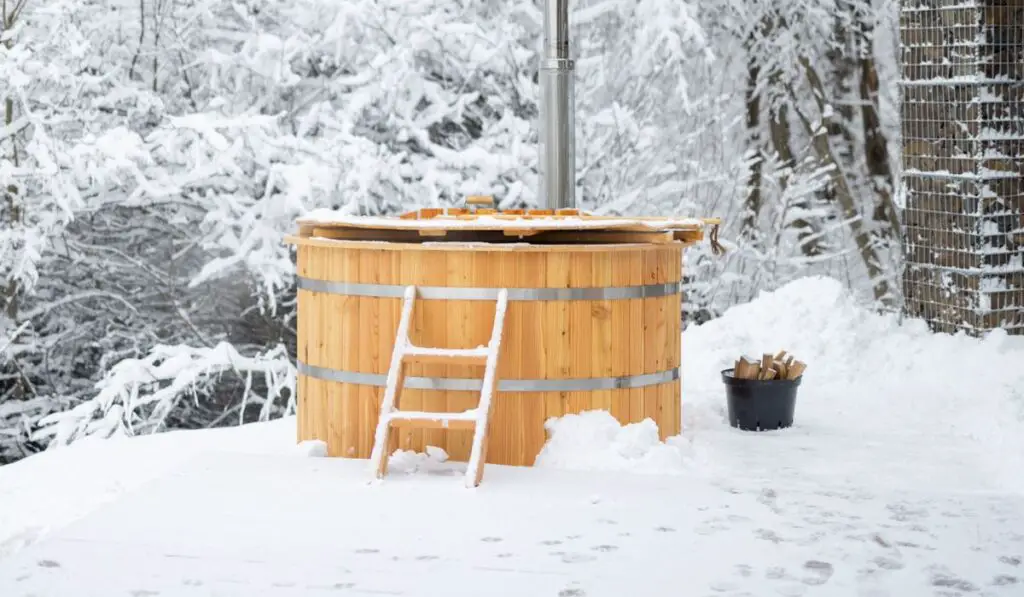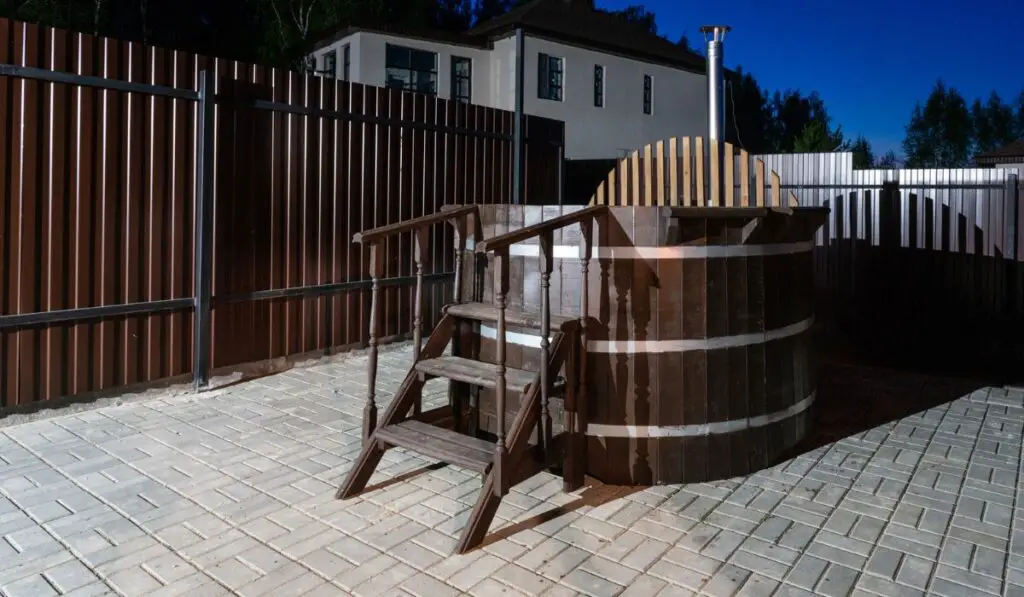It’s hard to imagine a more soothing and relaxing experience than enjoying your time in a steaming hot tub with nothing but the scent of cedar around you and the sound of a crackling fire to provide some background noise. Investing in a wooden hot tub is the best way to create your sanctuary while getting in touch with nature and your inner self.
Western red cedar hot tubs are durable, rot-resistance, and economical, whereas Alaskan yellow cedar hot tubs are popular for their beautiful appearance and exceptional strength. Snorkel, Roberts hot tubs, and Goodland are some of the best companies producing wooden hot tubs.
Although modern hot tubs come with multiple features like lights, hydrotherapy jets, waterfalls, etc., they lack the charm and aesthetics of a wooden hot tub. Let’s look at the different types of wood used to make hot tubs and what fuel is best to fire them up. We’ll also look at some of the best units available today.
Which Type of Wood is Best for Hot Tubs?

Although most woods used to construct wooden hot tubs are functional and beautiful, some may look and perform slightly better than others. Let’s take an in-depth look at these options:
Cedar
Cedar is considered the best type of wood for hot tubs due to its high tannin content, which prevents wood rot and makes it naturally waterproof. There are two types of cedar:
Western Red Cedar
One of the most popular options for a wood hot tub, the western red cedar is durable, tough, and rot-resistant. Go for tubs made from clear heart vertical grain with staves at least 1.75 inches thick, ensuring a more durable finish for your hot tub.
Western red cedar is also one of the most affordable options for a hot tub. Make sure that you stain the exterior of your hot tub at least once a year to maintain its original cedar color, or else it’ll eventually fade into gray.
And while we’re talking about it, just keep in mind that the insides of a hot tub are never stained.
Alaskan Yellow Cedar
Known for its high natural decay resistance, exceptional strength, and beautiful appearance, Alaskan yellow cedar, as the name suggests, has a unique pale yellow finish.
It’s a strong, durable option with a lovely natural flair for a hot tub. It has a beautifully smooth and clear grain with hardly any knots. In addition, its ability to resist warping and rot makes it ideal for wet conditions.
Teak
Burmese teak is a notable wood used in furniture building and high-quality yacht construction because of its strength, durability, beauty, appearance, stability, and resistance to damage from numerous acids, chemicals, and water.
In addition, teak contains more natural oils than other woods, allowing it to restore its original beauty and color from a weathered condition.
True teak is quite hard, which makes it difficult to shape and mill, but the finished product has a beautiful luster. These exceptional properties of teak, together with its weathering ability and superior rot resistance, make it one of the best options for hot tubs.
Although a bit expensive, teak is a luxury choice for people who want the very best in quality.
Do Wooden Hot Tubs Leak?
Wooden hot tubs don’t leak, provided that they are correctly assembled.
They are naturally waterproof; however, some new units may leak a little during the first few days as it takes a few days for the wood to swell, after which a tight seal develops between the staves making the tub watertight.
If your old hot tub develops a leak, it can be due to the following reasons:
- Your hot tub is so old that dry rot has set in.
- The base of your hot tub has shifted underneath it.
- The tub wasn’t assembled correctly.
- You’re adding too much bromine or chlorine.
Wood vs. Other Materials: How to Choose

A traditional wooden hot tub uses a wood-burning stove to heat water. However, the modern version of hot tubs provides several other heating options.
Wood Fired
In this traditional heating method, a log-burning stove is attached to the hot tub’s side, either internal (separated by a wooden fence) or external.
If the stove is inside the tub, it heats the water directly, but if the stove is external, the water flows out of the tub and passes the stove before coming back into the tub.
A wood-fired tub’s temperature can be easily controlled by the number of logs added to the stove. But this method of temperature regulation isn’t completely accurate compared to other heating methods.
You’ll need a floating thermometer to check the water temperature to ensure it doesn’t overheat or climb out of the hot tub to add more wood in case it gets too cold.
Electric
One of the most common methods of heating the water in your hot tub nowadays is electric heating. This option provides you with complete control over the water’s temperature with the help of a control panel close to the tub.
Install a 240V circuit in your home to successfully power the electric heater in your tub.
Gas/Propane
One of the best options for use in colder climates, propane and natural gas heaters are more cost-effective. You’ll need a gas line connected to the tub for this heater. When you turn on the gas heater, a small fire starts burning, heating the water as it flows over the heating element.
What are the Top Rated Wooden Hot Tubs on the Market?
The following are some of the best wooden hot tubs available concerning their design, quality, and aesthetics:
Snorkel
This Pacific Northwest Company has produced high-quality barrel cedar hot tubs and submersible wood-fired stoves since 1979.
All the wood used in the construction of their hot tubs is hand-selected for quality. So when you buy a hot tub from snorkel, you can expect to get the best in craftsmanship and precision.
Goodland
This Canadian firm uses sustainable western red cedar and locally-sourced materials to manufacture rectangular soaking tubs. Easy to assemble and move, Goodland hot tubs take very little time to set up.
Roberts Hot Tubs
Complimenting some of the most gorgeous resorts, homes, and estates since 1976, exquisitely- crafted wooden hot tubs from Roberts hot tubs are beautiful and unique.
The different varieties of hot tubs offered by the Roberts hot tubs include western red cedar, their most popular unit, and Alaskan yellow cedar and teak. These tubs are available in different sizes and shapes.
Berkeley Heat
Highly popular for their hand-produced hot tubs, Berkeley Heat has been around since 1976. Each of their hot tubs is a product of unparalleled dedication and craftsmanship. They offer a wide range of options, including customizable wooden hot tubs.
What are Wood-Fired Hot Tubs?
Wood-fired hot tubs are soaking tubs that use a wood-burning stove instead of an electric heater to heat fresh or saltwater. Typically made from cedar wood, these units are circular or barrel in shape. However, some rectangular versions can also be found.
These tubs are inspired by the traditional Japanese ofuros, deep soaking tubs constructed from hinoki cypress wood. Since these tubs aren’t fitted with jets, lights, or electricity, they offer an aromatic and quiet experience.
A wood-fired hot tub is constructed with a barrel-and-hoop design. Vertical cedar staves are placed together tightly in the shape of a barrel and secured with the help of stainless steel hoops.
As these tubs are usually made with a naturally decay-resistant and durable material like cedar, they tend to last a long time, with proper care for as long as 20 years, making them a more sustainable option than their acrylic counterparts.
Two different kinds of stoves can power a wood-fired hot tub:
- Submersible stove
- External stove
Submersible Stove
Made from durable marine-grade aluminum, submersible stoves used in hot tubs can resist corrosion. These units are fitted inside the hot tub and are submerged in the water.
Although an underwater stove may sound strange, it comes with an above-water stove pipe, stove door, and chimney, making it easier to build a fire. In addition, a built-in wooden fence ensures the safety of people using the hot tub.
External Stove
An external stove sits outside the hot tub and connects to it with two hoses. One hose pulls in the cooler water for heating while the other hose pushes the hot water out into the tub, continually circulating the water. This process is called thermosiphoning.
Although an external heater provides more space inside the hot tub, you’ll need to drain the hoses in freezing temperatures. A submersible stove, on the other hand, takes almost as much space as one person.
Consequently, submersible stoves are considered the best option as they heat water much quicker (although this may still take a couple of hours) and ensure a more efficient transfer of heat compared to an external stove.
